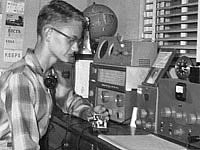John Fuller, K4HQK
(formerly KN4HQK, 1956)
The mystique of shortwave led me into ham radio. It began with reading the Hardy Boys series novel, "The Shortwave Mystery;" earning a "Radio" merit badge in the Boy Scouts (where I learned Morse); and discovering my parents had an old RCA radio in the attic with-Ah!-a shortwave band. In the small town of Barnwell, South Carolina, this was high drama.
 By age twelve (1954) I had built a Meissner 3BK three-tube regenerative receiver from a kit. To change bands, it was necessary to unplug one coil and insert another, then tweak the regeneration threshold just so for maximum sensitivity, without howling. By age twelve (1954) I had built a Meissner 3BK three-tube regenerative receiver from a kit. To change bands, it was necessary to unplug one coil and insert another, then tweak the regeneration threshold just so for maximum sensitivity, without howling.
Along the way I heard of amateur radio and wanted in. A business acquaintance of my grandfather's gave me an old one-tube ICA Signa-Tone code practice oscillator. Then a little ad in a radio magazine led me to an Army surplus J-38 telegraph key-for the grand sum of 99 cents.
A year later, at age thirteen, I was introduced to two dear, patient, supportive fellows in their late twenties-Herb Walters (KN4GDL) and "Kel" Kelley (KN4GLT)-who took me under their wings, demonstrated their commercial receivers and homemade, 10-watt 6L6-5U4G transmitters, and helped me practice code. A few months later (December 1956) I was ready for the exam. The FCC required that it be administered by a ham with a General class license, and the nearest such person was 14 miles away. I bummed a ride to his house and took the test on the kitchen table. Afterward this ham said I had passed the 20-question exam, which he then mailed off to the FCC. As I waited for the official decision, I begged my parents to persuade "Santa" to place a Heathkit AT-1 transmitter under our tree Christmas morning. "Santa" came through and I began soldering. A month later I turned 14 and a few days after that, my Novice license arrived in a little FCC envelope. I was to be KN4HQK, not quite the elegant call I had hoped for, but it was mine, and I was now ready to go on the air.
After finishing the AT-1 and getting the bugs out, I placed it on my desk next to the Meissner. Next I raised an 80-meter doublet. Then I plugged in the key and tapped it a few times. To my dismay, in the headset I didn't hear a clean CW tone but instead, a loud "Poomph! Poomph!" Something was still wrong with the AT-1, I thought, and resigned myself to going over the schematic yet again--unaware the problem was actually with the simple receiver, overloaded by the AT-1's strong signal.
A couple of weeks went by as I fussed over the "broken" transmitter. Then one night (February 21, 1956), while tuning around on the 80 meter novice band, I picked up KN4GAN calling CQ around 3720 kHz (k/c then). What the heck, I thought, I'll call him if for no other reason than to watch the AT-1's meter wiggle and get some code practice, and what does it matter my one and only crystal is some distance away on 3748. I called and listened, but . . . coming back to me in my headset was my own call sign. What! I picked up the pencil and began copying: RST 589, QTH Forsyth, GA, name is Jerry. I was suddenly in a pool of perspiration. I didn't even know all the numbers and had to write down dots and dashes for later translation. Then I sent my report, nervous and shaking, surely a mess, but he came back again and we chatted a few more minutes before sending our 73s. I had made my first contact and was floating high in the sky, somewhere near the ionosphere.
After many Novice QSOs that year I began to feel confined by the limited privileges, so I studied and passed the exam for a Conditional-class license (same test as the General class, only administered by a General class or higher volunteer instead of an FCC examiner). With that I said goodbye to the Novice bands, power limitations and crystal control, and was soon working DX on 20, 15 and 10 meters with a VFO and higher power. But nothing afterward could top the excitement of first getting on the air and hearing my call letters-in Morse code, on shortwave.
John Fuller
K4HQK |